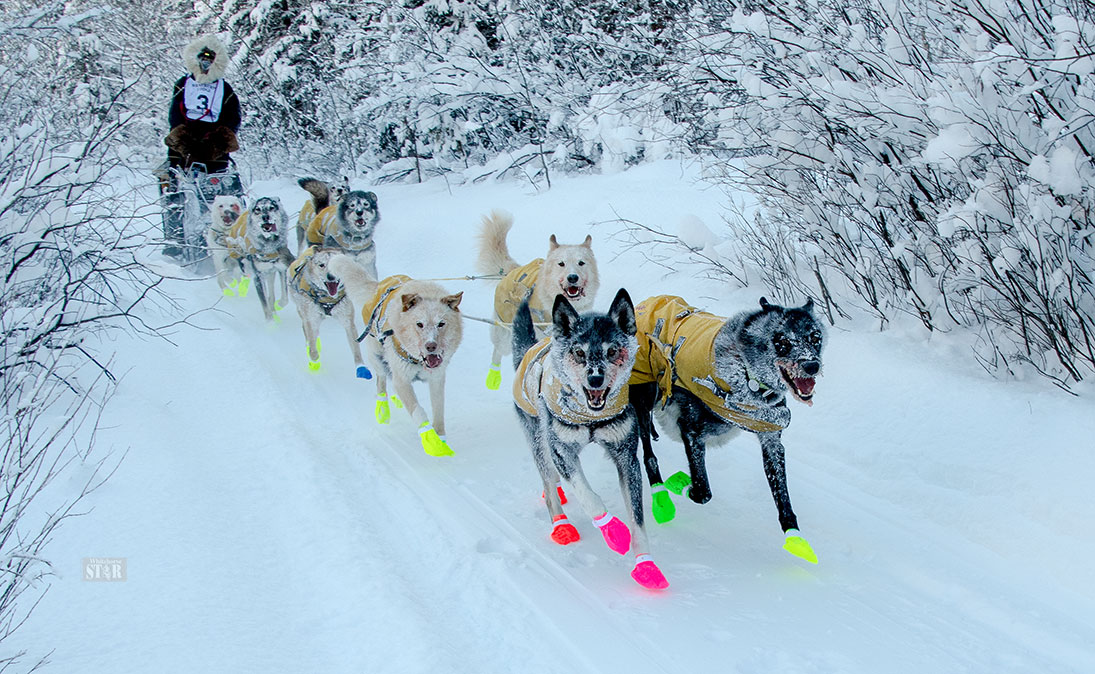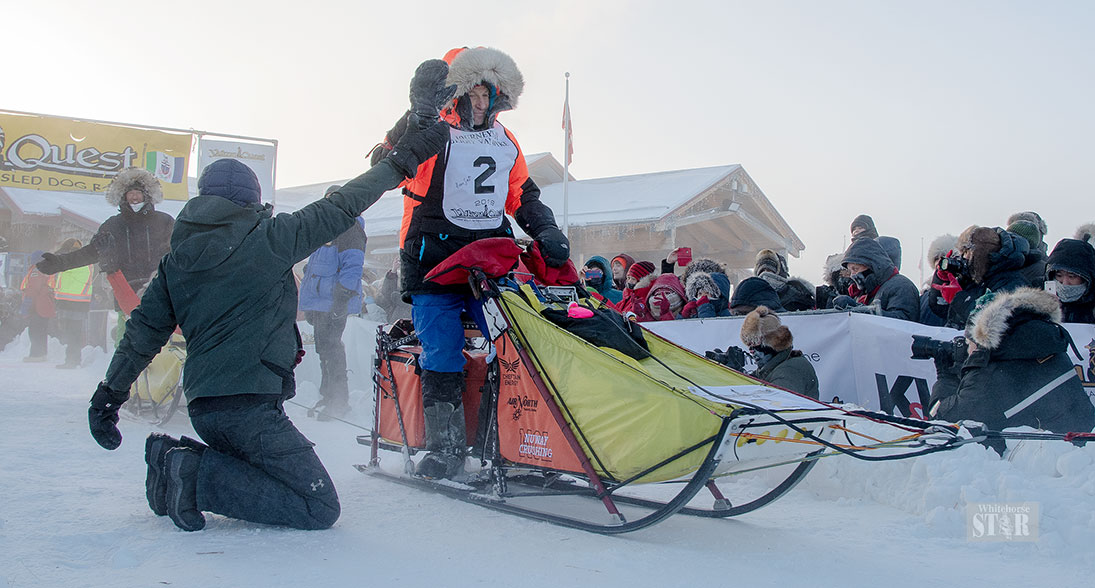
Photo by Whitehorse Star
HAPPY TRAILS – 2019 Yukon Quest winner Brent Sass mushes his team about 45 kilometres from the start of the race on Feb. 2.

Photo by Whitehorse Star
HAPPY TRAILS – 2019 Yukon Quest winner Brent Sass mushes his team about 45 kilometres from the start of the race on Feb. 2.

Photo by Whitehorse Star
HIGH FIVE – Hans Gatt leaves the start line of the 2019 Yukon Quest on Feb. 2. Gatt finished second that year in the last 1000 mile race.
The Yukon Quest 300 is changing course.
Revised - The Yukon Quest 300 is changing course.
According to a press release by the Quest, the race route for the Yukon Quest 300 on the Yukon side has been altered in response to new restrictions from the Yukon Government and CMOH.
The 2022 Yukon Quest 300 race route will run from Whitehorse, through Braeburn, to the north end of Mandanna Lake along the usual Yukon Quest Trail. Peter Heebink’s cabin on Mandanna Lake will serve as the halfway point turn-around. Teams will return on the same trail back to Whitehorse.
That means the route will no longer reach Pelly Crossing, Carmacks, and the homesteads of Stepping Stone and McCabe.
Yukon Quest President Susie Rogan explains why the route was changed.
“The COVID restrictions were updated effective Jan. 8 and it further reduced the amount of people who could be indoors together and it just became impossible ... (to be) using the indoor facilities at Carmacks and Pelly.”
The race will finish in Whitehorse at approximately mile 300.
“We would have not changed the route if it weren’t for the new restrictions, because we really did want to visit the Yukon Quest family in Pelly and Carmacks and Stepping Stone. McCabe was already off for other reasons, but the new route actually has its benefits as well. For sure there’s going to be a really good trail going back, because it’s an out and back now,” explained Rogan.
“It changes the stops from eight potential stops to five, but the race route is only 18 miles shorter ... it’s all camping out now. There’s not going to be any indoor facilities for the mushers. It might be more attractive for some people, to stay out on the trail. We still have Braeburn and we’re using it on the way out and the way back, but mushers will be sleeping in their trucks, or in a tent that their handler sets up, because we can’t use indoor facilities.”
Rogan says it’s an advantage for some mushers to not have to stay in a place, with everything else that goes along with that.
“Absolutely. There’s a lot of action, a lot of things going on if you’re going into the checkpoints, and this simplifies things for people. They’re going to have to be a little more self-reliant. On the other hand, it’s quiet, and you get to spend more time out with your dogs; there’s definitely positives as well.”
Has there been any reaction from racers yet?
“Just requests to finish up the new rules so they know what’s going on exactly, and (we) did finish that (Tuesday) and sent them out,” said Rogan.
“But I did talk to one musher last night who ... is planning to sign up for the 300. So I don’t think it’s going to impact anybody, like in terms of ‘oh, I can’t handle it anymore, if I can’t go in at Carmacks and Pelly and Stepping Stone I don’t wanna do it’ ... (I) haven’t heard back from anybody yet.”
Regular sign-up ends on Jan.19. Late sign-up ends Feb. 12. Late fees are $50 for the 100, and $100 for the 300. Entry fees are $100 for the 100, and $500 for the $300, all in Canadian dollars.
The recent changes in restrictions have, of course, had an effect on the latest planning for the race.
“We normally have in-person ticketed events – the start banquet, the finish banquet, the mushers Quest Fest. However, we’ll still do the bib draw and some kind of finish event for the mushers, but they’re going to be online blended events so that people from around the world and around the country and in-town as well can watch over the Internet I guess through Facebook or the website,” related Rogan.
“We did have a meeting last night with our ... events committee, and we’re working on how to do blended events so people can see still watch the bib draw, hear the mushers’ speeches and unfortunately, with a limit of 25 people indoors, it’s not like we can have a banquet or a Meet the Mushers event.
“The posters will still be signed and available through our website and through our store on Front Street,” added Rogan.
She said there comes a time when you have to stick with a plan.
“We just accepted reality, because we were having an event, kind of a blues cocktail party at the Transportation Museum for our sponsors, and we just can’t do that. But if things change in the next seven days, we might try to resurrect that. But it gets to a point where you just can’t plan. Like if getting to three and a half weeks before the event, it gets pretty difficult to make a plan.”
However, Rogan said you have to be prepared to roll with the waves.
“We’re still doin’ the race and we’re doing everything we can do. It’s not got us down or anything. We’re just ‘hey, this is reality’, it’s kind of like driving a boat over the waves and you’re just like ‘oh, got to turn this way, got to do that’, just doing what we’re able to.”
The Quest team regrets that they will not be stopping in at Pelly, Stepping Stone, McCabe and Carmacks.
“Both Pelly and Carmacks invited us and were going to set up facilities for us, which is great,” said Rogan. “But we’re sad to have another year where we don’t have an opportunity to connect, because the Yukon Quest, right from the beginning, has been about visiting the communities along the trail and not just communities, but homesteads and people’s cabins. That’s part of the race. That’s definitely part of the whole experience.”
The race will go as far as Peter Heebink’s cabin on Mandanna Lake.
“We’re using his place as a turnaround, so he’s definitely ... a very important time station,” stated Rogan.
“I know from being in Yukon Journey last year that they were bringing chilli out to people, mandarin oranges, had a couple of teenage guys helping park teams and there was a little bonfire and it was just a really nice stop and I ended up staying there an extra hour and a half,” recalled Rogan.
The mandatory rest has been reduced from 32 hours to 28 hours.
“We took two hours off for the shorter trail, and another two hours off so teams are not required to languish longer than the mushers might like to, in a single place,” said Rogan.
“The reason the mandatory rest has been reduced is not just because the trail is 18 miles shorter, but rather than eight potential places to rest, there’s only five and we thought it might get a little excessive for people, so the ratio of run to rest is a little lower than it was before. It’s still totally sufficient, but with only five places to stop, we thought we would chop off a little more,” explained Rogan.
“Historically the 300 is won by teams that rest a lot less than this, but we are creating a race where teams do not have to cut rest to win. The goal is to give everyone, including the front runners, a chance to enjoy the race more. On the other hand, we don’t want to make the race too far out of what is normal for these top racing teams. We hope that what happens is that they get a chance to enjoy the race more by being able to get some sleep themselves, while still feeling that they are running their dogs to their optimal capacity,” she added.
The 2022 Yukon Quest will remain a 300 mile qualifier for the Yukon Quest 1000, and a 300 mile qualifier for the Iditarod.
The route for the 100 mile race and the Alaskan races remains the same.
In order to encourage thoughtful and responsible discussion, website comments will not be visible until a moderator approves them. Please add comments judiciously and refrain from maligning any individual or institution. Read about our user comment and privacy policies.
Your name and email address are required before your comment is posted. Otherwise, your comment will not be posted.
Be the first to comment